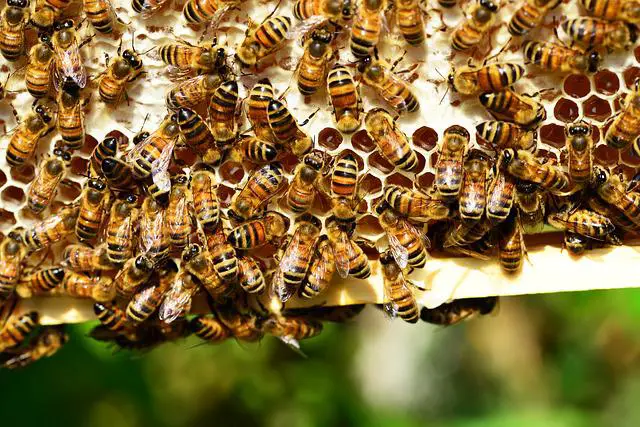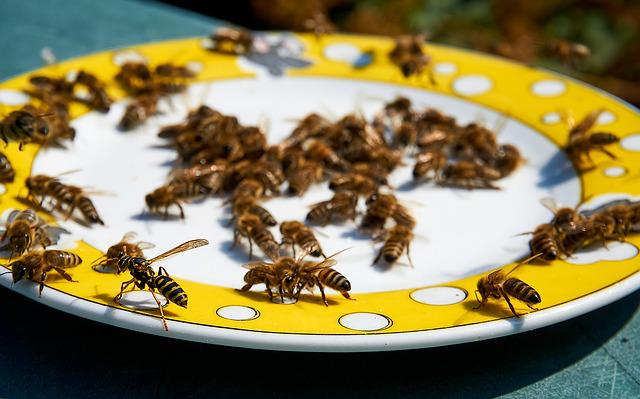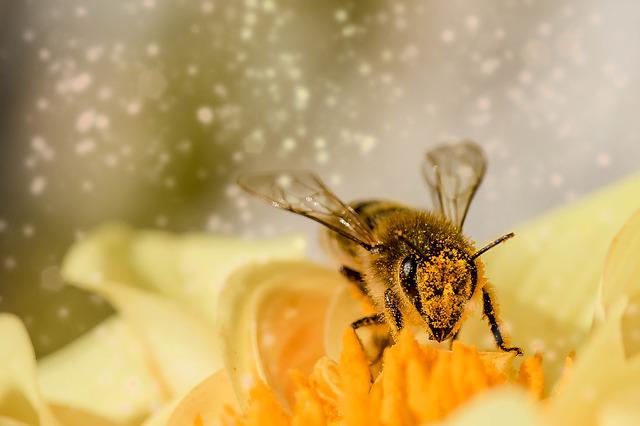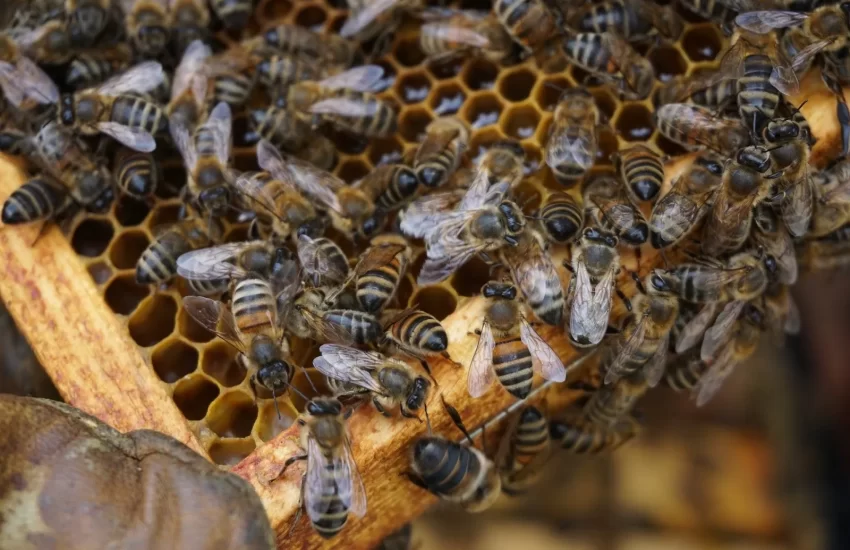How to feed bees in summer and winters

Honey bees work extra hard to ensure their colonies have abundant food and reserves for winter. However, it is not always possible for them to have sufficient food stores in all seasons. In times of scarcity, a beekeeper should offer extra food resources to help the bees survive and not lose them in the cold winter season.
The colonies may have insufficient honey stores due to a lack of nectar and pollen or poor foraging conditions. Summer storms and flooding rain hinders the bees from harvesting available nectar.
Similar Articles you may like to read –
Can bees survive without sugar water?
How to wrap a beehive for cold winters
How much honey should I leave for winter?
How do you winterize a beehive?
Can a bee nuc survive the winter?
Instances When Feeding is Essential
- In early spring, when your colony is coming from the wintering season. You may continue to feed your bees if the spring weather is stormy so that they may continue with brood rearing.
- After you install a bee package
- After capturing a swarm, you should feed it to encourage the bees to stay.
- In times of drought.
- When there are inadequate food stores for the winter season.
- When your colony is recovering from a disease infestation.
- After pesticide losses, to build up a colony.
- When a beekeeper wants to build colonies for an optimum population in times of nectar flows.
Supplement Feeding in Bees

Sugar Supplementation
You can supplement nectar in the form of honey in combs or sugar syrup made by mixing sugar with water. A thin syrup is fed in spring, summer, and early fall to stimulate the colony to increase brood; 1 part of sugar to 1 part of water. Thick sugar syrup is given to the bees in late fall. It is made by mixing 2 parts of sugar with 1 part of water.
How to Make Sugar Syrup for Your Bees
- Make a mixture of sugar and water, depending on the season.
- Heat the mixture gently until all sugar dissolves.
- Remove the mixture from the heat and let it cool to room temperature.
- Put it in a feeder and present it to your buzzing friends.
To check when your bees need food supply, you can set up a small bowl of sugar syrup out in the open. If they swarm over it within hours, then there is insufficient nectar, and you should feed them. When there is sufficient forage, they will ignore the syrup and go forage instead.
Pollen Substitutes

Beekeepers substitute pollen in early spring before the very first blooms. Pollen promotes brood rearing, strengthens the health of the bees, and enables them to be more productive. The best way to ensure your bee colony has adequate pollen is to safeguard the abundant pollen-bearing plants close to the bees.
If the colony’s pollen stores are insufficient, you can offer pollen substitutes. Some of the ingredients used to make pollen supplements include soybean flour, sunflower flour, brewer’s yeast, wheast, linseed flour, peanut flour, and fish meal. You can also buy prepared patties or protein cakes. Most commercial supplements are attractive to bees, provide honeybee nutritional requirements, and are readily available.
Some beekeepers trap pollen in their bee colonies using pollen traps to feed their bees in times of scarcity. A pollen trap is a device that forces the field bees to enter through a series of screens that scrape off the pollen as they get into the hive from their foraging trips. The pollen falls in a collection tray underneath. A pollen trap is placed in front of a beehive. It has holes that allow bees to get in but are big enough to pass with pollen. To get into the hive, they have to shed off the pollen. The collected pollen is then stored by freezing inside zip-close bags.
Qualities of a Good Pollen Substitute
Palatable
When a supplement is tasty, the bees will readily consume it.
Digestible
Honeybees should be able to digest and absorb in their systems.
Nutritious
It should contain quality proteins, vitamins, and minerals in the right proportions to enhance the growth and development of the brood and bees.
Feeding Bees in Spring
The earliest part of spring can be a dangerous moment for your bees since most of the colonies deplete the winter stores. You should feed your colony at this time before the plentiful floral sources are available. The bees have been eating the honey stores throughout the winter and are beginning to rebuild their numbers. This means that the queen is laying eggs. Feeding them with a thin sugar syrup stimulates brood production and helps the colony build up as it prepares for the spring nectar flow. A thin syrup is 1 part of sugar to 1 part of water.
Feeding Bees in Summer
Dry summers can result in a shortage of pollen and nectar. If bees have inadequate food resources this season, you should feed them with thin sugar syrup. The thin syrup fed to bees resembles the nectar flows from plants, and queens are stimulated to lay eggs.
Feeding Bees in Autumn
Early autumn feeding is done with a thin sugar syrup to stimulate brood production, while late fall feeding is done with a thick syrup (2 parts of sugar and 1 part of water). A thick sugar syrup to ensure they have enough honey reserves for winter. The bees don’t have enough time to remove water from the syrup to turn it into honey. Providing them with a thicker syrup reduces the amount of work that bees have to do.
Don’ts in Feeding Bees in Spring, Summer, and Fall
- Don’t feed the bees with honey supers in place. It will affect the quality of honey that you will harvest. The honey will be sweet but will not be honey.
- Quit feeding when the nectar sources are available. You know there are abundant sources when you see foragers returning to the hive with full pollen sacs.
- Avoid open feeding. It leads to robbing.
- Don’t offer pollen substitutes in the fall. It stimulates brood production before the cold month will increase the demand in the food stores.
Feeding Bees in Winter

There are diverse reasons why a beekeeper may want to feed the bees in winter. However, this should not be the same way you feed your bees in warmer months. In the warm months, you can give them syrup, but it will affect them negatively in the cold season.
The best way to feed your bees in winter is by providing them with candy or fondant. You just need to use white sugar crystals to make candy and add supplements to it to make it appealing to the bees. When the sugar is hard, the bees consume it with ease.
How to Make Fondant for the Bees
Fondant is also known as bee candy. It is a prevalent method of winter feeding and acts as a substitute for honey. Unlike syrup, fondant is dry, and bees can use it right away. Honey contains inverted sugars: glucose and fructose, while white sugar that you purchase at the grocery store is pure sucrose.
Granulated sugar is hard for the bees to digest unless it is broken down. You can heat the sugar with an organic acid such as vinegar, citric acid, or cream of tartar. It will cause the sugar to go through an inversion process that creates fructose and glucose. That is why most beekeepers prefer fondant over dry sugar. You can make fondant ahead of time and store it in a freezer in gallon zip lock bags.
What you will need
- A large saucepan
- A hand or electric mixer
- A cooking thermometer
- Shallow disposable setting pans
Ingredients
- Four parts of white sugar
- 1 part of water
- ¼ teaspoon of vinegar per pound of sugar
- ¼ teaspoon of salt (preferably containing beneficial minerals)
Procedure
- Pour sugar, water, and vinegar into a saucepan and bring them to boil, stirring constantly.
- When the mixture starts to boil, stop stirring, put the lid on, and allow it to boil for 3 minutes.
- Take off the lid from the saucepan and check the temperature. Continue to boil with the lid off until the mixture attains a temperature reaches 234F.
- Remove from heat and cool to 200F.
- When the fondant gets down to 200F, use a mixer to whip until the mixture turns cloudy white and creamy with air bubbles. The process takes a few minutes.
- Pour into a shallow setting pan.
- Allow cooling undisturbed. The process can take several hours.
To feed your bees, place two strips of fondant on the top bars of your brood box so that the bees can access it. The natural moisture in the hive will allow them to feed on the fondant efficiently. Check-in your beehive after every few weeks to see how much they have eaten, and add more fondant if necessary.
CAUTION:
Hot candy can cause severe burns. It is extremely hot and sticky and does not come out of your skin quickly. Ensure to keep young children away as you are preparing.
Why You Should not Feed Your Bees with Syrup in Winter
It Makes the Bees too Active
When bees drink syrup, what will run in their mind is to make honey since it has too much water in it. This process will make the bees work harder and burn a lot of energy that is normal in winter. The sugar syrup contains about 33% water content, and they will want to bring it down to 18%.
It is Too Cold to Get to the Syrup
Winter is usually extremely cold, and bees cluster together to maintain warmth. In this position, they can’t quickly get food when they need it. Surprisingly, they can even starve to death when there are frames of honey in the nest which are not close to the cluster. Since most syrup feeders are located away from outside the hive, they cannot reach the food. The syrup also gets too cold to consume.
The Syrup Can Form Molds
The syrup’s shelf life is relatively short and will start to form molds in a couple of weeks. If it becomes moldy, the bees will probably not consume it.
It Will Take too Long to Warm Up
In the evenings, the syrup will chill quickly, and its temperature will match that of the air. When the day warms, it will take time to warm; hence too cold for the bees.
Don’ts of Feeding in Winter
Never feed your bees on liquid sugar when they are clustered
Honey bees will rarely feed on a watery substance when it is below 50 degrees Fahrenheit. They will only consume honey or candy boards (sugar cakes) in winter because of the high sugar content.
Add Protein to the Candy
Table sugar lacks micronutrients that are present in honey. Bees will not survive on sugar alone in winter. They also require proteins which you can easily add to the candy boards.
Don’t Allow the Supplied Foods to Diminish
Don’t allow the candy boards to go completely empty. Replace on time.
Don’t feed your colony with sugar that contains additives
Additives increase the chances of bee dysentery in your bees. Brown sugars include molasses while commercial fondants may have colorings or flavorings. High fructose corn syrup may contain hydroxymethylfurfural(HMF), which is poisonous to bees. It is advisable to use white table sugar.
Don’t Feed Your Colony With Unknown Food Sources
Never feed your colony with honey from unknown sources. It may contain spores of diseases such as American Foulbrood.
When to Start Feeding Bees for Winter
If there is no dependable fall nectar flow in your region, you should start feeding your bees early enough( 6 weeks before the cold season). This heavy syrup( 2 parts of sugar and 1 part of water) encourages storing honey in the comb. When there is heavy fall nectar flow, a colony can mainly make more honey to stock up for the winter. There may even be an excess for you to harvest.
More articles you may like to read –
Can a bee nuc survive the winter?
Can I take honey from a first year hive?
How much honey does 1 hive produce per year?
How many bees should be in a hive for winter? How many brood boxes do you need for winter?
FAQs
What is the best time to feed your bee colony?
You should feed a bee colony when there is a shortage of nectar and pollen or when there are unfavorable weather conditions for foraging. You also feed the bees when there are insufficient honey stores to overwinter.
Can you overfeed the bees?
Providing your bees with sugar syrup when natural sources are available is unhealthy since it lacks the vital nutrients that bees require.
Do you have to feed any colony before winter?
Not every colony needs to be fed. If the bee colonies have enough honey stores, they will overwinter without any food problems.
What is the best food for bees?
Honey is the perfect food for honey bees.
What amount of honey do bees require in winter?
A honey bee colony will need at least 60 pounds of honey. This depends on the duration of winter and the size of the colony. Some bee colonies overwinter with a more significant population, requiring more food stores. Again, if you experience a long winter season in your region, you will need more honey stores for your bees.



